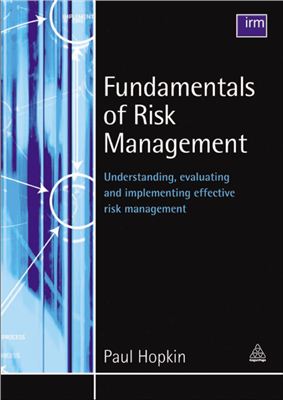This book is intended for all who want a comprehensive introduction
to the theory and application of risk management. It sets out an
integrated introduction to the management of risk in public and
private organizations. Studying this book will provide insight into
the world of risk management and may also help readers decide
whether risk management is a suitable career option for them.
Many readers will wish to use this book in order to gain a better understanding of risk and risk management and thereby fulfil the primary responsibilities of their jobs with an enhanced understanding of risk. This book is designed to deliver the syllabus of the Inteational Certificate in Risk Management qualification of the Institute of Risk Management. However, it also acts as an introduction to the discipline of risk management for those interested in the subject but not (yet) undertaking a course of study.
An introduction to risk and risk management is provided in the first Part of this book and the key features of risk management are set out in the next two Parts. Parts 4, 5 and 6 concentrate on the application of risk management tools and techniques, as well as considering the outputs from the risk management process and the benefits that arise.
We all face risks in our everyday lives. Risks arise from personal activities and range from those associated with travel through to the ones associated with personal financial decisions. There are considerable risks present in the domestic component of our lives and these include fire risks in our homes and financial risks associated with home ownership. Indeed, there are also a whole range of risks associated with domestic and relationship issues, but these are outside the scope of this book.
This book is primarily conceed with business and commercial risks and the roles that we fulfil during our job or occupation. However, the task of evaluating risks and deciding how to respond to them is a daily activity not only at work, but also at home and during leisure activities.
Many readers will wish to use this book in order to gain a better understanding of risk and risk management and thereby fulfil the primary responsibilities of their jobs with an enhanced understanding of risk. This book is designed to deliver the syllabus of the Inteational Certificate in Risk Management qualification of the Institute of Risk Management. However, it also acts as an introduction to the discipline of risk management for those interested in the subject but not (yet) undertaking a course of study.
An introduction to risk and risk management is provided in the first Part of this book and the key features of risk management are set out in the next two Parts. Parts 4, 5 and 6 concentrate on the application of risk management tools and techniques, as well as considering the outputs from the risk management process and the benefits that arise.
We all face risks in our everyday lives. Risks arise from personal activities and range from those associated with travel through to the ones associated with personal financial decisions. There are considerable risks present in the domestic component of our lives and these include fire risks in our homes and financial risks associated with home ownership. Indeed, there are also a whole range of risks associated with domestic and relationship issues, but these are outside the scope of this book.
This book is primarily conceed with business and commercial risks and the roles that we fulfil during our job or occupation. However, the task of evaluating risks and deciding how to respond to them is a daily activity not only at work, but also at home and during leisure activities.

